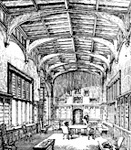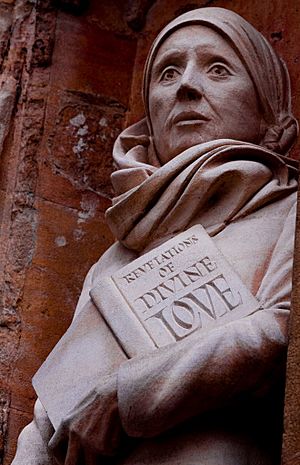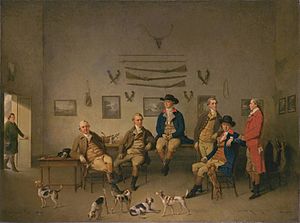Carrow Abbey facts for kids
Quick facts for kids Carrow Abbey |
|
|---|---|
 |
|
| General information | |
| Type | Benedictine priory |
| Architectural style | Norman |
| Location | Bracondale, Norwich, Norfolk, England |
| Coordinates | 52°37′4.8″N 1°18′38.9″E / 52.618000°N 1.310806°E |
| Completed | 1146 |
Carrow Abbey is an old Benedictine priory in Norwich, England. A priory is like a monastery, but usually smaller. This one was for nuns. The area around it used to be a village called Carrow. That's where Carrow Road gets its name. This is the famous football ground for Norwich F.C., which is very close by.
King Stephen gave the land for the priory around 1146. It became a special listed building in 1954, meaning it's important to protect.
Contents
History of Carrow Abbey
How the Priory Started
We don't know the exact date Carrow Abbey began. But we do know that King Stephen gave land in Norwich for a new church. He wanted nuns to build their church there.
Two sisters, Seyna and Lescelina, started building the priory in 1146. They named it "St. Mary of Carhowe." It was a home for a prioress (the head nun) and nine "black nuns." Later, the community grew to twelve nuns.
The nuns worked to get more land for their priory. They even gave King Stephen a sparrowhawk to change some words in their land charter! Later, King John and King Henry III also confirmed their land ownership.
Important Nuns and Challenges
A famous anchoress (a religious hermit) named Julian of Norwich might have trained at Carrow Priory in the 1350s or 1360s. Her writings show she knew a lot about Benedictine ways.
In 1396, a nun named Edith Wilton became the prioress. There were about eleven nuns living there at the time. The priory had about £118 per year in income.
In 1414, a big argument started. The Prioress of Carrow, Edith Wilton, and the Prior of Holy Trinity disagreed over who owned certain lands. The court decided that Carrow was part of the City of Norwich, which meant Edith Wilton won. She also won other legal cases. For example, she was accused of hiding a murderer, but she accused the monks of chasing away her cattle! Edith Wilton had strong support from important people. In 1419, the nuns and monks finally made peace.
Edith Wilton passed away in 1430. Another prioress, Margaret Pygot, took over in 1445. She was very good at managing the priory's money. She increased its yearly income from £117 to £169. She used this money to buy more land for the convent. Margaret Pygot also built a new dormitory and fixed the convent's mill.
The convent was also involved in handling wills (documents about what happens to someone's property after they die). They often helped carry out people's last wishes.
Between 1529 and 1539, there were two priests and eight women servants at the priory. In 1538, the priory was closed down. Its buildings and valuable items were given to Sir John Shelton.

Later Years of Carrow Abbey
By 1712, a man named Nathaniel Axtell owned the site. He wrote about some of the priory's history.
In 1811, the Martineau family bought the Carrow Abbey estate. They were a well-known medical family who had found safety in Norwich from religious persecution. Philip Meadows Martineau, a famous surgeon, bought the land. He built a beautiful house called Bracondale Hall nearby. He also used stones from the old Carrow Abbey ruins to build a "small gothic priory" on his land.
By 1879, the famous company J &J Colman owned Carrow Abbey. They kept it for many years. Between 1899 and 1909, they did a lot of repair work and even added a new part to the Abbey. In July 1900, the Colman family hosted the Prince of Wales (who later became King Edward VII) at Carrow Abbey for a fancy lunch.
Carrow Abbey became a Grade I listed building in 1954. This means it's a very important historical site. The Abbey has been featured in famous paintings, like one from 1780 by Philip Reinagle showing "the Carrow Abbey hunt."
Archaeologists have studied the priory site several times. They looked at the old Norman buildings and the rooms and gardens from the 1500s and late 1800s.
What Carrow Abbey Looks Like
Outside the Priory

The very first parts of the priory were built in 1146. But most of the rooms you see today are from the early 1500s and late 1800s. The priory is made of dark flint stones with red bricks and a tiled roof. It has two floors and three main sections. The left part was once a parlor, the middle was the main hall, and the right part was added in the late 1800s.
The old parlor, also called the Prioress's Parlor, has wooden windows. A small window sticks out from the first floor. On one of the old doors, you can see the letter "Y" and a gun carved in wood. This was a special symbol for Isabella (Elizabeth) Wygun, who was one of the last prioresses of Carrow.
The main hall in the middle has a square window that sticks out. It also has a tall wooden window at the back. A porch was added in the late 1800s. The brickwork here is mostly from the 1500s. The part of the building on the right was added in the late 1800s. It has a cool pattern of red bricks on the flint walls.
Inside the Priory
Most of the rooms inside Carrow Abbey were changed in the 1500s and again in the late 1800s by the Colman family. The entrance hall has a large stone fireplace with the date 1900 carved on it.
The right side of the building has fancy molded plaster ceilings. You can see these in the dining room and the rooms upstairs. The parlor on the left side has wooden panels and a fireplace from the 1500s. A beautiful staircase with detailed carvings leads up to the first floor. The bedrooms upstairs also have decorative ceiling beams.

